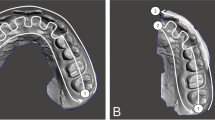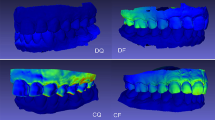Abstract
Purpose
To determine the variation of OXIS contact areas in primary molars using digital impressions generated from an intraoral scanner (IOS).
Methods
A cross-sectional study was carried out on 214 caries-free posterior quadrants of 80 children (38 males and 42 females) aged 3–6 years. Calibration of taking digital impressions with the IOS procedure was performed initially through scanning of ten quadrants of children to provide a learning environment to the examiner. The digital impressions were then exported, and the type of interproximal contact areas present between the distal surface of the primary first molar and the mesial surface of the primary second molar were identified according to the OXIS classification. The prevalence of the types of OXIS contact areas was expressed in the form of numbers and percentages. The chi-square test was applied to investigate the variability among the arches and to understand the association of OXIS contact areas across age, gender, and arches.
Results
The most common contact area type observed was I-type (59.8%), followed by S-type (15.4%), X-type (12.6%), and O-type (12.2%). The I-type contact area was most frequently seen in both males (51.6%) and females (65.5%), while the S-type contact area in males (14.7%) and X-type contact area in females (8.4% each) were the least frequent with no statistical significance between genders (p > 0.05). All three age groups studied showed the highest prevalence of the I-type contact area, which increased with an increase in age (p < 0.05). The inter-arch comparison showed a significant result in terms of the X-type contact area on the right side, and O-type, X-type, and I-type contact areas on the left side, while no statistical difference was seen in the intra-arch comparison for all contact types.
Conclusion
I-type contact areas were the most prevalent across the arches, age groups and genders.



Similar content being viewed by others
Data availability
The data will be available on request.
References
Akay G, Sait Karatas M, Karadag O, Ucok O, Gungor K. The incidence of artifacts in cone beam computed tomography images: a pilot study. Ann Med Res. 2021;26(11):2581–6.
Allison PJ, Schwartz S. Interproximal contact points and proximal caries in posterior primary teeth. Pediatr Dent. 2003;25(4):334–40.
Altherr ER, Koroluk LD, Phillips C. Influence of sex and ethnic tooth-size differences on mixed-dentition space analysis. Am J Orthod Dentofacial Orthop. 2007;132(3):332–9. https://doi.org/10.1016/j.ajodo.2005.08.043.
Andrade C. Sample size and its importance in research. Indian J Psychol Med. 2020;42(1):102–3. https://doi.org/10.4103/IJPSYM.IJPSYM_504_19.
Bishara SE, Jakobsen JR, Treder J, Nowak A. Arch width changes from 6 weeks to 45 years of age. Am J Orthod Dentofacial Orthop. 1997;111(4):401–9. https://doi.org/10.1016/s0889-5406(97)80022-4.
Bosoni C, Nieri M, Franceschi D, Souki BQ, Franchi L, Giuntini V. Comparison between digital and conventional impression techniques in children on preference, time and comfort: a crossover randomized controlled trial. Orthod Craniofac Res. 2023;26(4):585–90. https://doi.org/10.1111/ocr.12648.
Burdi AR, Moyers RE. A Handbook of Orthodontics. 4th ed. Yearbook Medical Pub Inc; 1998
Cortes A, Martignon S, Qvist V, Ekstrand KR. Approximal morphology as predictor of approximal caries in primary molar teeth. Clin Oral Investig. 2018;22(2):951–9. https://doi.org/10.1007/s00784-017-2174-3.
Debnath D, Kar S, Bhattacharya S, Zahir S, Lahiri PK. A clinico-observational study of proximal contacts in primary molars among Bengali children. J Coast Life Med. 2023;11(1):2608–15.
Eswara K, Avula JS, Mallela GK, Enuganti S, Margana JG, Kakarla P. Deciduous molar sizes and sexual dimorphism: South Indian study. J Pediatr Dent. 2014;2:13–9.
Gohil KS, Talim ST, Singh I. Proximal contacts in posterior teeth and factors influencing interproximal caries. J Prosthet Dent 1973;30(3):295–302.
Jang TJ, Yun HS, Hyun CM, Kim JE, Lee SH, Seo JK. Fully automatic integration of dental CBCT images and full-arch intraoral impressions with stitching error correction via individual tooth segmentation and identification. arXiv preprint arXiv:2112.01784. 2022.
Keating AP, Knox J, Bibb R, Zhurov AI. A comparison of plaster, digital and reconstructed study model accuracy. J Orthod. 2008;35(3):191–175. https://doi.org/10.1179/146531207225022626.
Khan R, Singh N, Govil S, Tandon S. Occlusion and occlusal characteristics of primary dentition in North Indian children of East Lucknow region. Eur Arch Paediatr Dent. 2014;15(5):293–9. https://doi.org/10.1007/s40368-014-0113-4.
Kirthiga M, Muthu MS, Kayalvizhi G, Krithika C. Proposed classification for interproximal contacts of primary molars using CBCT: a pilot study. Wellcome Open Res. 2018;3:98. https://doi.org/10.12688/wellcomeopenres.14713.2.
Kirthiga M, Muthu MS, Lee JJC, et al. Prevalence and correlation of OXIS contacts using cone beam computed tomography (CBCT) images and photographs. Int J Paediatr Dent. 2021;31(4):520–7. https://doi.org/10.1111/ipd.12687.
Kirthiga M, Muthu MS, Kayalvizhi G, Mathur VP, Jayakumar N, Praveen R. OXIS contacts and approximal caries in preschool children: a prospective cohort study. Caries Res. 2023;57(2):133–40. https://doi.org/10.1159/000529160.
Koyoumdjisky-Kaye E, Zilberman Y, Zeevi Z. A comparative study of tooth and dental arch dimensions in Jewish children of different ethnic descent. I. Kurds and Yemenites. Am J Phys Anthropol. 1976;44(3):437–43. https://doi.org/10.1002/ajpa.1330440307.
Kravitz ND, Groth C, Jones PE, Graham JW, Redmond WR. Intraoral digital scanners. J Clin Orthod. 2014;48(6):337–47.
Kumari S, Sharma A, Sharma K, Singh C. OXIS contact area variations in primary molars among three to five year aged preschool children. Eur Chem Bull. 2023;12(4):2321–31.
Lysell L, Myrberg N. Mesiodistal tooth size in the deciduous and permanent dentitions. Eur J Orthod. 1982;4(2):113–22. https://doi.org/10.1093/ejo/4.2.113.
Mangano F, Gandolfi A, Luongo G, Logozzo S. Intraoral scanners in dentistry: a review of the current literature. BMC Oral Health. 2017;17(1):149. https://doi.org/10.1186/s12903-017-0442-x.
Marques S, Ribeiro P, Falcão C, et al. Digital impressions in implant dentistry: a literature review. Int J Environ Res Public Health. 2021;18(3):1020. https://doi.org/10.3390/ijerph18031020.
Mathewson R J, Primosch RE. Fundamentals of Pediatric Dentistry. 3rd ed. Quintessence Publishing Co. Inc; 1995.
Moorrees CFA, Thomsen SO, Jensen E, Yen PKJ. Mesiodistal crown diameters of the deciduous and permanent teeth in individuals. J Dent Res. 1957;36(1):39–47. https://doi.org/10.1177/00220345570360011501.
Moussa C, Hardan L, Kassis C, et al. Accuracy of dental photography: professional vs smartphone’s camera. Biomed Res Int. 2021. https://doi.org/10.1155/2021/3910291.
Muthu MS, Kirthiga M, Kayalvizhi G, Mathur VP. OXIS classification of interproximal contacts of primary molars and its prevalence in three- to four-year-olds. Pediatr Dent. 2020;42(3):197–202.
Muthu MS, Kirthiga M, Lee JC, et al. OXIS contacts as a risk factor for approximal caries: a retrospective cohort study. Pediatr Dent. 2021;43(4):296–300.
Oeë M. Changes in position and development of human anterior tooth germs after birth. Okajimas Folia Anat Jpn. 1968;45(2):71–82.
Padmanabhan V, Madan B, Shahid S. Occlusion and occlusal characteristics of the primary dentition in Emirati schoolchildren. Dent J. 2021;54(2):92–5.
Rajbhoj AA, Parchake P, Begnoni G, Willems G, Cadenas de Llano-Pérula M. Dental changes in humans with untreated normal occlusion throughout lifetime: a systematic scoping review. Am J Orthod Dentofacial Orthop. 2021;160(3):340–3623. https://doi.org/10.1016/j.ajodo.2021.02.014.
Serrano-Velasco D, Martín-Vacas A, Paz-Cortés MM, Giovannini G, Cintora-López P, Aragoneses JM. Intraoral scanners in children: evaluation of the patient perception, reliability and reproducibility, and chairside time-a systematic review. Front Pediatr. 2023;11:1213072. https://doi.org/10.3389/fped.2023.1213072.
Subramaniam P, Babu Kl G, Nagarathna J. Interdental spacing and dental caries in the primary dentition of 4–6-year-old children. J Dent (tehran). 2012;9(3):207–14.
Sun KT, Li YF, Hsu JT, et al. Prevalence of primate and interdental spaces for primary dentition in 3- to 6-year-old children in Taiwan. J Formos Med Assoc. 2018;117(7):598–604. https://doi.org/10.1016/j.jfma.2017.07.010.
Theodorakou C, Walker A, Horner K, Pauwels R, Bogaerts R, Jacobs R. Estimation of paediatric organ and effective doses from dental cone beam CT using anthropomorphic phantoms. Br J Radiol. 2012;85(1010):153–60. https://doi.org/10.1259/bjr/19389412.
Thongthammachat S, Moore BK, Barco MT 2nd, Hovijitra S, Brown DT, Andres CJ. Dimensional accuracy of dental casts: influence of tray material, impression material, and time. J Prosthodont. 2002;11(2):98–108.
Walia T, Kirthiga M, Brigi C, Muthu MS, Odeh R, Pakash Mathur V, et al. Interproximal contact areas of primary molars based on OXIS classification – a two centre cross sectional study. Wellcome Open Res. 2021;5:285.
Yilmaz H, Aydin MN. Digital versus conventional impression method in children: comfort, preference and time. Int J Paediatr Dent. 2019;29(6):728–35. https://doi.org/10.1111/ipd.12566.
Acknowledgements
None
Funding
None.
Author information
Authors and Affiliations
Contributions
The authors have made substantial contributions to the conceptualisation and design of manuscript. TS, TW, RSM, EB, RH and AAJ have been involved in data interpretation, drafting the manuscript, and revising it critically and have given final approval of the version to be published.
Corresponding author
Ethics declarations
Conflict of interest
None.
Additional information
Publisher's Note
Springer Nature remains neutral with regard to jurisdictional claims in published maps and institutional affiliations.
Rights and permissions
Springer Nature or its licensor (e.g. a society or other partner) holds exclusive rights to this article under a publishing agreement with the author(s) or other rightsholder(s); author self-archiving of the accepted manuscript version of this article is solely governed by the terms of such publishing agreement and applicable law.
About this article
Cite this article
Thekiya, T.S.A., Walia, T., Shetty, R.M. et al. Variation of OXIS contact areas in primary molars among 3–6-year-old children with intraoral digital scanning. Eur Arch Paediatr Dent (2024). https://doi.org/10.1007/s40368-024-00902-w
Received:
Accepted:
Published:
DOI: https://doi.org/10.1007/s40368-024-00902-w




